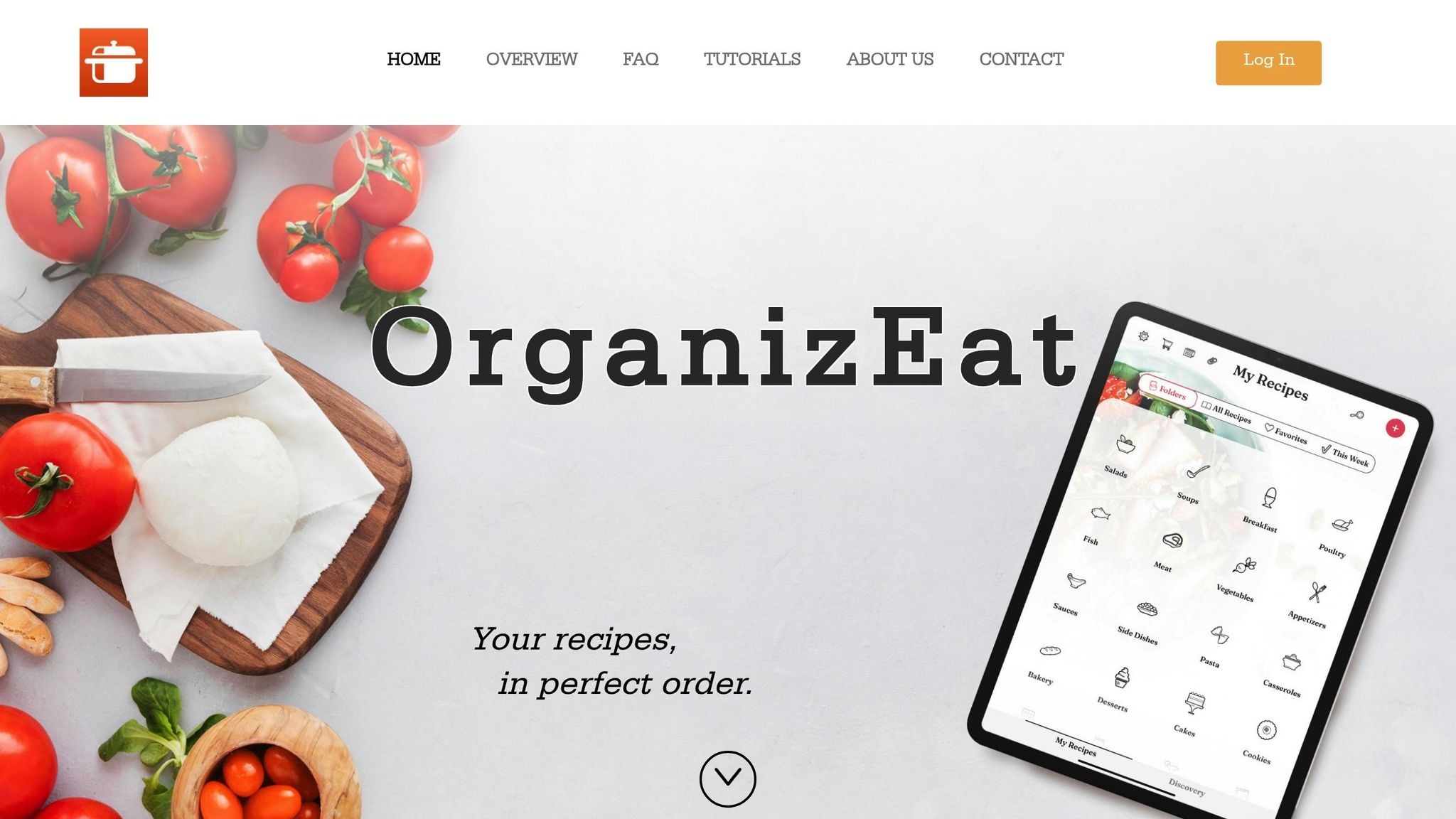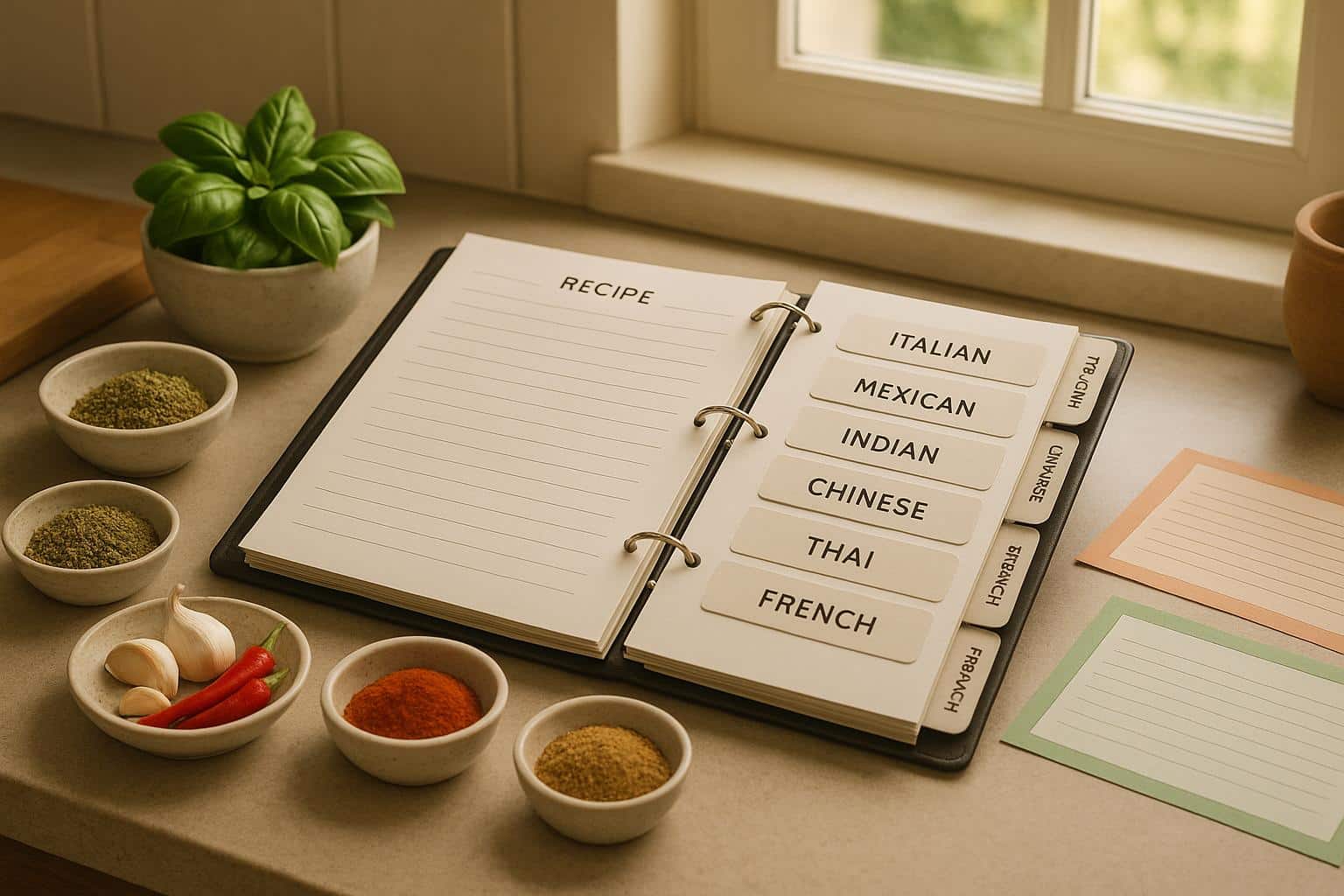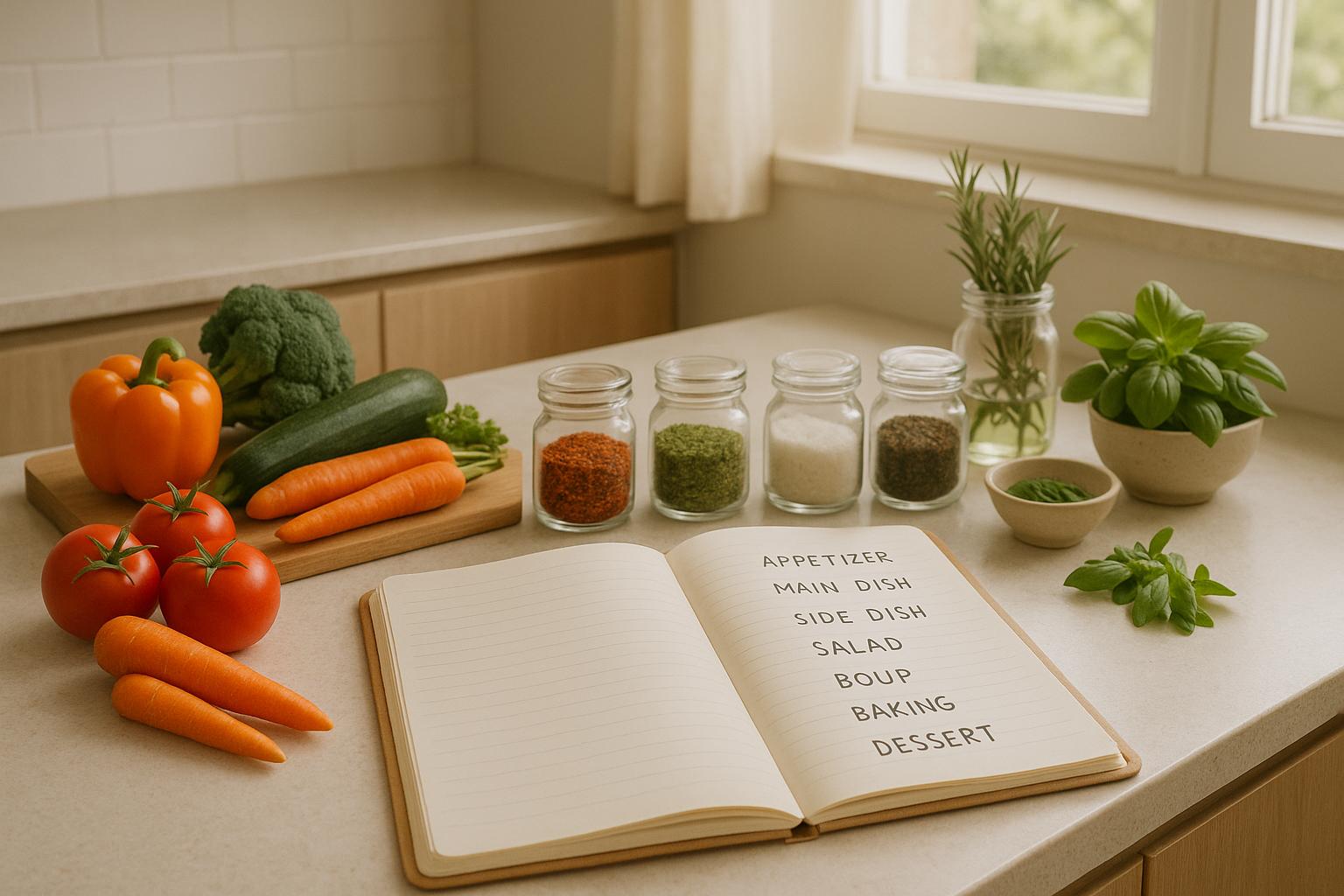Family recipes are more than food – they’re memories, stories, and connections. Digitizing these traditions ensures they last for generations. Here’s how you can do it:
- Scan Recipe Cards: Use a scanner or smartphone to save handwritten recipes digitally.
- Organize a Recipe Collection: Create folders, add tags, and build a searchable archive.
- Record Cooking Videos: Capture family members demonstrating recipes and sharing stories.
- Use Recipe Apps: Tools like OrganizEat make saving and sharing recipes simple.
- Start a Food Blog: Document recipes with photos, stories, and step-by-step guides.
- Back Up to the Cloud: Store recipes securely and access them from anywhere.
- Create a Recipe Database: Build a searchable system with categories and notes.
- Cook Together Online: Host virtual cooking sessions to share recipes and memories.
Preserving family recipes digitally keeps traditions alive, makes sharing easier, and safeguards them for future generations.
Preserving Family Recipes: How to Create a Collaborative …
1. Scan and Save Recipe Cards
Preserving your family’s cherished recipes starts with digitizing those treasured recipe cards. Use a good scanner or your smartphone to create clear, high-quality digital copies.
Handle old recipe cards with care, especially if they’re written on delicate materials like thin paper or newsprint. Once scanned, store the originals in protective sleeves to ensure they last for future generations.
If you’re using your smartphone, try scanning apps that can deliver excellent results. Many of these apps include helpful features like:
- Automatic edge detection to frame the card perfectly
- Perspective correction to straighten out skewed images
- Color adjustment for better readability
- Text recognition for converting handwriting or typed text into digital text
Here’s how to get the best scan possible:
- Clean your phone’s camera lens and make sure your workspace is well-lit.
- Place the card on a dark, contrasting surface for better edge detection.
- Hold your phone steady and keep it parallel to the card.
- Check your scans right away to ensure they’re clear and complete.
These steps will help you create a reliable digital archive of your recipes.
"Genius Scan has to be one of the best apps on my phone. I rarely use it, but when I do – it’s so magical. ✨ Faster (and easier) than a scanner…" – Blake Robbins
Once you’ve scanned your recipes, keep everything organized with a clear folder system on your computer or cloud storage. You could sort recipes by:
- Cuisine (e.g., Italian, Mexican)
- Meal type (e.g., Breakfast, Dinner, Desserts)
- Special occasions (e.g., Holidays, Birthdays)
- Family member (e.g., Grandma’s Recipes, Mom’s Favorites)
For even easier access, name each file descriptively – include the recipe name and main ingredients. You can also add tags for things like cooking time, dietary preferences, or special occasions, which makes searching a breeze.
If you have handwritten recipes that are tough to read, try using Optical Character Recognition (OCR) tools. OCR can turn those handwritten notes into editable text, making them easier to share while still keeping the charm of the original handwriting.
2. Build a Digital Recipe Collection
Once you’ve scanned your recipes, keeping them organized is crucial for creating a family archive that’s easy to use and share.
Start by setting up a well-structured digital library. Use folders to categorize recipes into groups like Family Favorites, Holiday Traditions, Seasonal Specialties, and Heirloom Recipes.
"Recipes are our memories, our topics of conversation, our ways of expressing ourselves, and our daily companions." – Rachel, Lead Software Developer for OrganizEat
Pay attention to file names and tagging. Instead of generic names like "cookies.pdf", go for something more specific, such as "Grandma-Rose-Christmas-Sugar-Cookies-1965.pdf." Add tags for things like main ingredients, cooking time, dietary needs, or special occasions to make searching a breeze.
For larger collections, consider creating a digital index using a spreadsheet. Include columns for:
- Recipe Name: Aunt Mary’s Apple Pie
- Category: Desserts
- Origin Date: 1955
- Special Notes: Uses Pink Lady apples
- Season/Holiday: Fall, Thanksgiving
- Prep Time: 45 minutes
Adding notes about substitutions, family memories, or serving tips can bring the recipes to life and make them even more meaningful.
To keep everything safe and accessible, back up your collection regularly to cloud storage. In November 2022, organizing expert Sabrina Quairoli highlighted how tools like Tinyscanner and recipe-title-based folders can simplify the process.
Keep your archive fresh by updating recipes with tweaks or new additions. This way, you’ll preserve not just the recipes but also the family stories behind them.
3. Make Cooking Tutorial Videos
Videos can preserve family traditions in a way nothing else can – capturing moments like Grandma kneading dough or Dad’s unique seasoning style that might otherwise fade over time.
If you’re planning to create cooking videos with your family, focus on these three steps to make your tutorials engaging and memorable:
- Plan Ahead
Choose a recipe that holds meaning for your family and works well on camera. Clear your workspace and have all ingredients prepped and measured. For lighting, natural daylight is ideal, so set up near a window during the day. If filming at night, a ring light can provide even, bright lighting.
- Set Up Your Gear
You don’t need fancy equipment – a modern smartphone on a sturdy tripod will do the job. For better sound, use a clip-on microphone. Experiment with angles: overhead shots for mixing, eye-level for cooking on the stovetop, and close-ups for techniques.
- Tell the Story
The magic of these videos lies in the stories behind the recipes. Before filming, talk to family members about the dish’s background. For example:
"When she cooks, she pretty much just wings it every time. It’s not like ‘you need 200 grams of flour for this’, it’s pretty much a scoop of this, a scoop of that."
While filming, make sure to include details like measurements, substitutions, doneness cues, and any unique tips.
For editing, beginner-friendly apps like CapCut or iMovie are great options. Add on-screen text for key steps and soft background music to keep the focus on the cooking process. These videos do more than teach a recipe – they preserve cherished family stories for years to come.
4. Store Recipes in OrganizEat

Organizing family recipes digitally is a breeze with OrganizEat, a tool designed to keep your cherished recipes safe and easy to access.
Start by using the Snap ‘n’ Store feature to photograph handwritten recipe cards or pages from cookbooks. The app’s scanning function ensures even old, worn-out cards are clear and easy to read. Want to save recipes from the internet? The Web Import feature lets you grab recipes from over 200 websites, so you don’t have to worry about losing them if they’re taken down.
The app also allows you to personalize your recipes. Add Grandma’s cooking tips, Dad’s secret ingredients, or notes about family traditions – all while keeping that personal touch intact.
Sharing recipes is simple too. You can share your collection with up to five family members, creating a growing digital cookbook as everyone adds their own twists to beloved dishes.
To make cooking easier, OrganizEat offers a Cooking Mode that displays recipes in full screen – no distractions while you’re preparing meals. You can also organize your collection with custom folders. Group recipes by family member, occasion, or tradition, and use searchable tags and notes to quickly find holiday favorites or dishes tied to specific family branches.
Worried about losing your recipes? The app’s cloud backup system keeps everything secure and synced across your devices. Whether you’re cooking on a tablet at home or accessing your recipes on your phone while shopping, OrganizEat ensures your family’s culinary legacy is always at your fingertips. It works seamlessly across iOS, Android, and web browsers.
sbb-itb-6688478
5. Document Recipes Through Blogging
Starting a food blog dedicated to your family recipes turns cherished dishes into a digital keepsake, preserving not just the ingredients and steps but also the stories and traditions behind them. Like digitized recipes or video tutorials, blogging brings these recipes to life in a way that’s easy to share.
A successful food blog combines engaging storytelling with eye-catching visuals. Use natural light to take high-quality photos of your dishes, and include step-by-step images to guide readers through the process. Adding videos can also boost engagement, as studies suggest they grab attention more effectively.
"As we record the thoughts, ideas, and processes of our traditional family meals we create an heirloom that will be handed down to our children, grandchildren and great-grandchildren. We build a bridge by which our loved ones can learn about who we are, even after we are gone from this world." – Kate Walling
When documenting your recipes, make sure to include:
- Recipe Origins: Share who first made the dish and how it became a family favorite.
- Personal Memories: Highlight occasions or moments when the dish was served.
- Recipe Evolution: Note any changes or tweaks over time.
- Cultural Significance: Explain how the dish fits into your family’s heritage.
Adding personal anecdotes, like making pancakes on Sundays or baking cookies during the holidays, can make your blog feel more relatable and heartfelt. These small details preserve the emotional ties to each recipe.
To reach a wider audience, ensure your blog is mobile-friendly. Features like a "Jump to Recipe" button for longer posts and well-organized ingredient lists improve the experience for readers on smaller screens.
You could also organize your blog into themed series, such as holiday recipes, seasonal favorites, or signature family dishes. This structure not only makes it easier for readers to explore but also reflects the rhythm of your family’s cooking traditions throughout the year.
6. Back Up Recipes to Cloud Storage
Using cloud storage is a smart way to keep your recipes safe and accessible across all your devices. It ensures your culinary treasures are protected while staying easy to find and share. Start by creating a structured system to organize your digital recipes.
Use clear, descriptive filenames like 2025_Holiday_ChocolateChipCookies_GrandmaJane or 2025_MainDish_SpaghettiBolognese_Family. This makes it simple to identify recipes at a glance. You can also organize your folders by meal type, cuisine, occasion, or even dietary requirements.
"Shorter filenames improve clarity in file listings." – The Family Curator
When picking a cloud storage provider, compare their features to find the right one for your needs. Here’s a quick overview of some popular options:
| Provider | Free Storage | Starting Paid Plan |
|---|---|---|
| Google Drive | 15GB | $1.99/month (100GB) |
| Apple iCloud | 5GB | $0.99/month (50GB) |
| Microsoft OneDrive | 5GB | Various plans available |
| IDrive | 10GB | Premium options available |
To keep your recipes secure while sharing them with family, follow these tips:
- Enable two-factor authentication for your cloud account.
- Use strong, unique passwords.
- Share recipes via secure links instead of public folders.
- Regularly monitor account activity for unauthorized access.
- Back up your collection to multiple storage locations for added safety.
Take high-quality photos of your recipes to preserve every detail. Add relevant tags to your digital files so family members can easily search for specific dishes, especially during holidays or special events.
Cloud storage doesn’t just protect your recipes – it preserves cherished family traditions. With every update, your digital cookbook grows, ensuring your family’s culinary legacy continues to thrive.
7. Set Up a Recipe Database
Creating a searchable recipe database is a great way to preserve your family’s culinary traditions and make it easier to find those beloved dishes. Start by organizing your recipes into categories that reflect your family’s cooking habits and heritage.
Here are some ideas for organizing your database:
| Category Type | Examples |
|---|---|
| Meal Type | Breakfast, Lunch, Dinner, Snacks |
| Occasion | Holidays, Family Gatherings, Weeknight Meals |
| Season | Summer BBQs, Winter Comfort Food |
| Source | Grandma’s Collection, Mom’s Specialties |
| Dietary | Gluten-Free, Vegetarian, Kid-Friendly |
This structure helps you lay a solid foundation for adding detailed information.
Go beyond the basics by documenting the story behind each recipe. Include details like who created it, when it first appeared, and any family memories tied to it. For example, note the recipe name, its origin, and the special occasions it’s associated with.
To make your database even more useful, consider adding:
- Personal notes: Jot down any tweaks that worked well.
- Serving suggestions: Suggest side dishes or accompaniments.
- Preparation tips: Include family secrets or techniques.
- Photos: Add pictures of the finished dishes and any handwritten recipe cards.
- Tags: Use keywords to make searching faster.
Keep your database updated with notes on ingredient substitutions, portion changes, or cooking time adjustments. Over time, it will grow into a rich collection of your family’s cooking expertise.
Finally, include ratings for each recipe after you’ve tried it. A simple 1-5 star system works well to highlight family favorites or must-make dishes for special occasions. This makes planning meals and celebrations a breeze.
8. Cook Together Online
Virtual cooking sessions are a great way to keep family culinary traditions alive, even when you’re miles apart. These online gatherings allow everyone to share cherished recipes, techniques, and stories while creating new memories together.
Plan ahead to make the experience smooth. Choose a recipe and set a date at least one to two weeks in advance. Share a detailed ingredient list and instructions with everyone so they have time to prepare. Here’s a simple timeline to follow:
| Preparation Stage | Key Actions |
|---|---|
| 1-2 Weeks Before | Pick the recipe, set the date, and list ingredients |
| 1 Week Before | Share the recipe and instructions; confirm who’s joining |
| 2-3 Days Before | Shop for groceries and check your equipment |
| Day Of | Test your video setup and prep your workspace |
When it’s time to cook, set up your space for a clear and engaging experience. Position your device – preferably a tablet or laptop – for a stable and well-lit view of your cooking area. This ensures everyone can easily follow along.
"Family recipes show that we have this whole album of memories that predated the pandemic. And we’ll have more after the pandemic", says Anne Fishel, director of the Family Dinner Project.
Make the session even more meaningful by encouraging storytelling. While cooking, ask older family members to share memories tied to the dish, like the first time they made it or special occasions when it was served.
"Focus on the experience. Talk about the sights, experiences, sounds – because all of that is culture and all of that will make a difference to the developing identity of children and the family".
Virtual cooking has proven to be more than a temporary trend. In the ‘Cook Along Challenge,’ 85% of families said they planned to continue these sessions even after resuming in-person gatherings. This shows how these digital traditions bring people closer.
To make the most of your virtual cook-along, try these tips:
- Use screen sharing to show tricky techniques
- Take screenshots or record the session to capture the moment
- Have everyone present their finished dishes at the end
- Plan regular sessions – monthly or quarterly – to keep the tradition alive
Conclusion
Digitally preserving family recipes helps create lasting bonds across generations. By using the eight methods discussed, families can establish a digital collection that keeps their culinary traditions alive and easy to access. These approaches not only safeguard recipes but also strengthen the connection to family history.
Food memories are among the most powerful we form, according to research. Digitizing recipes and cooking experiences allows families to preserve the stories, techniques, and wisdom passed down over time. Lisa Hamblin, an educator with Oklahoma State University Extension, highlights this sentiment:
"Cooking together is a wonderful hands-on activity that results in tasty food to eat and creates memories among generations".
Digitizing recipes offers several advantages:
| Advantage | Impact on Family Traditions |
|---|---|
| Accessibility | Recipes can be accessed anytime, anywhere |
| Preservation | Protects against physical loss or damage |
| Collaboration | Family members can share and contribute |
| Adaptability | Traditions can grow while keeping their essence |
To make your digital archive more meaningful, consider hosting regular family cooking sessions. Involve younger family members in documenting recipes, giving them a deeper appreciation for their culinary roots while teaching valuable skills.
"Recipes are our memories, our topics of conversation, our ways of expressing ourselves, and our daily companions".





